提喻和换喻
隐喻·换喻·提喻——论中国当代情爱叙事的身体修辞
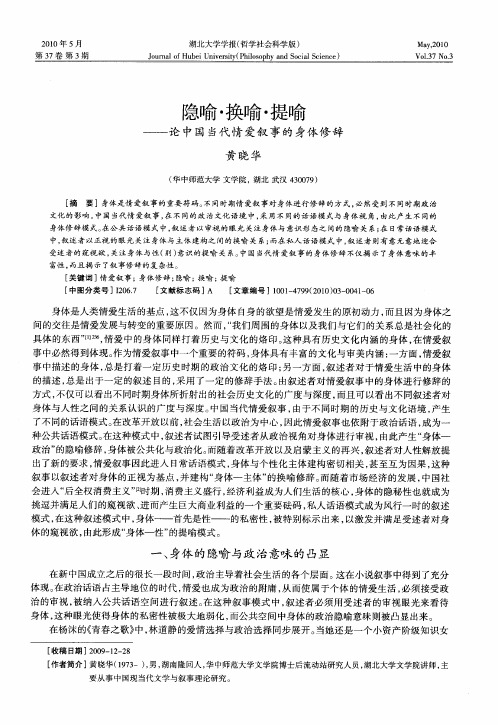
文化的影 响。 中国当代情 爱叙 事 , 不 同的政 治文化语境 中, 在 采用 不 同的话语 模式 与身体视 角 , 由此 产生不 同的 身体修 辞模式 。 在公共 话语 模式 中 , 述者 以审视 的眼光 关注身体与 意识 形 态之 间的隐喻 关系 ; 日常话语模 式 叙 在
中, 叙述者 以正视 的 眼光关注 身体 与主体建构之 间的换喻 关 系; 而在私人 话语模式 中 , 述者则有 意无意地迎合 叙
身 体 与人 性 之 间 的关 系 认 识 的广 度 与 深 度 。 国 当代 情 爱叙 事 , 中 由于不 同时 期 的历史 与文 化 语 境 , 生 产 了不 同 的话语 模 式 。 改革 开放 以前 , 在 社会 生 活 以政 治 为 中心 , 因此 情 爱叙 事 也 依 附于 政 治话 语 , 为 一 成
种公共话语模式 。 在这种模式中, 叙述者试 图引导受述者从政治视 角对身体进行审视 , 由此产生“ 身体一 政治” 的隐喻修辞 , 身体被公共化与政治化 。 而随着改革开放以及启蒙主义 的再兴 , 叙述者对人性解放提 出了新的要求 , 情爱叙事 因此进入 日常话语模式 , 身体与个性化主体建构密切相关 , 甚至互为 因果 , 这种 叙事以叙述者对身体的正视为基点 , 并建构“ 身体一 主体 ” 的换喻修辞 。 而随着市场经济的发展 , 中国社 会进入“ 后全权消费主义”_ , _ 2 时期 消费主义盛行 , 经济利益成为人们生活的核心 , 身体 的隐秘性也就成为
身体 , 这种眼光使得身体的私密性被极大地弱化 , 而公共空间中身体 的政 治隐喻意味则被凸显 出来。 在杨沫的《 青春之歌》 林道静的爱情选择与政治选择同步展开。 中, 当她还是一个小资产阶级知识女
[ 收稿 日期 ] 0 9 1— 8 20 — 2 2
英语修辞与写作

第一章明喻、暗喻、换喻、提喻第一节明喻1.1.1 明喻(Simile)的定义The definition of simile-A simile is a figure of speech involving the comparison of one thing with another thing of a different kind by using the words:as,like,as…as,etc.Another definition:A figure of speech in which one thing is likened to another,in such a way as to clarify and enhance an image.It is an explicit comparison(as opposed to the metaphor where the comparison is implicit)recognizable by the use of the word“like”or“as”.有学者认为,“一事物”可称为“本体”,而“另一事物”最好称为“喻体”。
请看例句:New China is like a red sun rising in the east.(本体)(比喻词)(喻体)从例句结构上看,明喻包括“本体”(subject or tenor)和“喻体”(reference or vehicle)。
本体指被比喻的对象,喻体指用来做比喻的对象,比喻词用在本体和喻体之间起连接介绍作用。
从词源上讲,simile源于拉丁词similis,其意义相当于英语介词like(像)。
弄明白了本体、喻体和比喻词,对于理解和掌握明喻是大有裨益的。
1.1.2 明喻的例解1.1.2.1 用like或as引导1.My heart is like a singing bird.(C.G Rossetti:A Birthday)我的心如小鸟在歌唱。
换喻和提喻
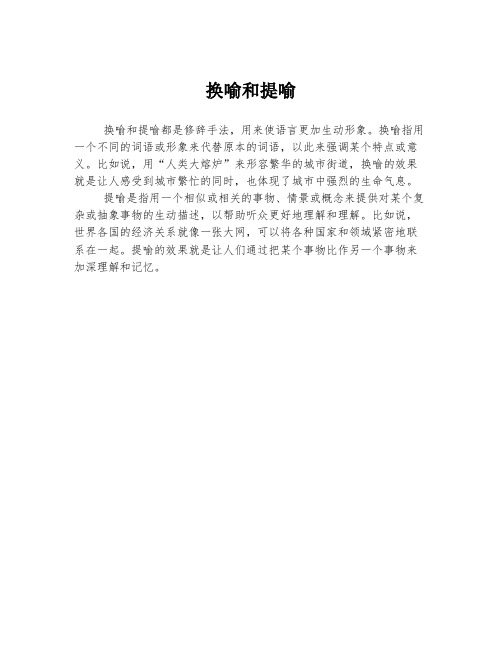
换喻和提喻
换喻和提喻都是修辞手法,用来使语言更加生动形象。
换喻指用一个不同的词语或形象来代替原本的词语,以此来强调某个特点或意义。
比如说,用“人类大熔炉”来形容繁华的城市街道,换喻的效果就是让人感受到城市繁忙的同时,也体现了城市中强烈的生命气息。
提喻是指用一个相似或相关的事物、情景或概念来提供对某个复杂或抽象事物的生动描述,以帮助听众更好地理解和理解。
比如说,世界各国的经济关系就像一张大网,可以将各种国家和领域紧密地联系在一起。
提喻的效果就是让人们通过把某个事物比作另一个事物来加深理解和记忆。
浅析日语中的比喻表达

浅析日语中的比喻表达比喻是一种常用的修辞手法,用跟甲事物有相似之点的乙事物来描写或说明甲事物。
比喻就是“打比方”,即两种不同性质的事物,彼此有相似点,便用一事物来比方另一事物,使描写更加生动形象,说理更加通俗易懂的修辞方式。
发表论文比喻一般由三部分构成,即本体(被比喻的事物)、喻体(作比喻的事物)和比喻词( 比喻关系的标志性词语)组成。
例如:“真夏のような暑さ”,这个比喻句的本体是“暑さ”,喻体是“真夏”,比喻词是“ような”。
比喻表达是日本民族文化和语言中不可缺少的重要成分,它独特的语言功能和文化象征意义,反映着一个民族独到的修辞意识和文化传统。
一、日语比喻的种类1.直喻日语的直喻亦称明喻,是一种最常见的修辞方式。
它的特点是被比喻的事物,作比喻的事物和比喻词全部出现。
日语中常用的比喻词有“まるで·あたかも~のようだ(ごとし、みたいだ”。
例如:この雪はまるで绵のようです。
/这雪像棉花一样。
飞行机みたいな形のような形の云が浮かんでいる。
/漂浮着一朵像飞机形状的云彩。
光阴矢のごとし。
/光阴似箭。
上述例句使用了比喻词“まるで……ようだ”、“みたいだ”、“ごとし”,把被比的事物和作比的事物联系起来,构成明显的比喻关系。
汉语的明喻和日语的直喻两者格式相同,但是由于两个民族的表达习惯的差异,在翻译时有的就不能完全照搬原文的比喻形象。
如:お金を汤水のように使えた时代/挥金如土的时代。
日本水资源丰富,日本人爱洗澡世界闻名,他们比喻奢侈浪费时就用“汤水のように使えた”,而农耕大国的中国则形象地使用“挥金如土”比喻。
因此,在翻译成中文时,应翻译为“挥金如土”更为合适。
2. 隐喻日语的隐喻又称暗喻,它与直喻不同,不用比喻词,比喻关系隐藏在句子中。
直喻是相似的关系即A像B(AはのBようだ),隐喻是相合的关系即A是B(AはBだ)。
这是两种比喻的不同之处。
例如:あたりは一面の火の海だ。
/附近是一片火海。
人生とは旅である/人生就是旅行。
提喻和转喻
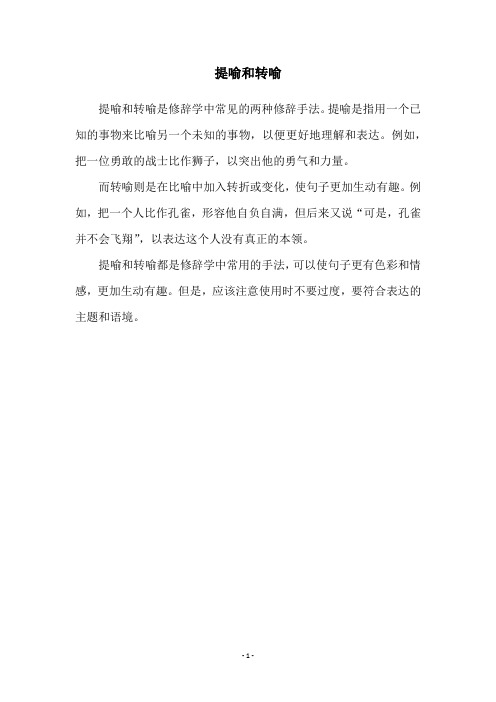
提喻和转喻
提喻和转喻是修辞学中常见的两种修辞手法。
提喻是指用一个已知的事物来比喻另一个未知的事物,以便更好地理解和表达。
例如,把一位勇敢的战士比作狮子,以突出他的勇气和力量。
而转喻则是在比喻中加入转折或变化,使句子更加生动有趣。
例如,把一个人比作孔雀,形容他自负自满,但后来又说“可是,孔雀并不会飞翔”,以表达这个人没有真正的本领。
提喻和转喻都是修辞学中常用的手法,可以使句子更有色彩和情感,更加生动有趣。
但是,应该注意使用时不要过度,要符合表达的主题和语境。
- 1 -。
提喻和转喻

提喻和转喻喻是一种有趣而强大的修辞手法,它通过比较不同的事物来传达思想和感悟。
在写作中,喻的使用可以丰富文章表达,使读者更能理解和共鸣。
其中,提喻和转喻是两种最为基本的喻法,下面将分步骤阐述它们的含义和使用方法。
一、提喻提喻是把具体的事物拿出来直接比较,让读者更容易理解抽象的概念。
比如,“喜欢一个人就像是喜欢一只猫,它总是让你感到温暖而舒适。
”这句话用猫来比喻爱情,让读者更加深刻地领会作者的情感。
使用提喻的步骤:1.确定比喻的主体和具体的事物,确保两者有足够的关联性和类比性。
2.在文章中列举出来,并用“像……一样”或“就像……”的连接词来表示比喻关系。
3.进一步解释比喻的寓意或表达自己的感受,使读者感同身受。
二、转喻转喻是把两个本来不相关的事物联系起来,用一个领域中的概念来解释另一个领域中的概念。
比如,“生命就像一场旅行,旅途中的经历让人成长,而最终的归宿是无法预料的。
”这句话用旅行来比喻生命,使读者更加生动地感受到人生的意义。
使用转喻的步骤:1.确定两个本来不相关的事物和比喻的主体,找出它们之间的相似之处。
2.在文章中运用比喻词汇和句式,用新的概念为旧的概念作出解释。
3.进一步探究所表达的内涵和深度,让读者产生更深入的思考。
总之,提喻和转喻是表达中非常基础而有用的手法,在写作中很容易被运用。
它们可以帮助读者更深入地理解抽象的概念,也可以让读者有更深刻的体验,并从中产生新的感悟。
需要注意的是,在使用喻的时候要遵循适度的原则,让比喻的意义和文本的主题符合,使文章更加通顺自然。
换喻、提喻和代称
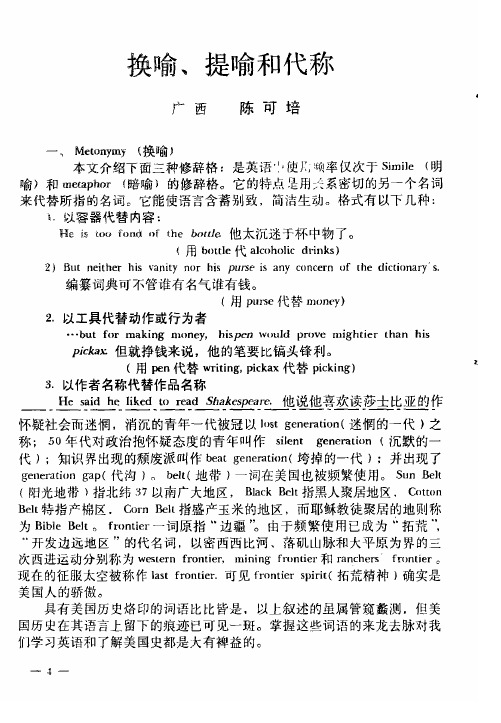
e
n
a n
n
o
e
《,
a r
t r: 二
e
t i《 川
.
,
f
、、 e a
川,
a ,l
d
m
o n
e
y)
。
第
m
th
o
4
种 格式 用得最 多
h
a
如
t ;
:
:
e r o
he
w
u n
g
r a
y
t ll
ha i
e
r
一
f
`
th
e
` ,
ld
拌
t
`)
, e ; 一 l
` ,n
g ,W e T
n a
e b、
(
.2
。
用
P: :
,、 e
代替
u
。,., n e
y)
以 工 具代替动作 或 行为者 …b u
尸
t
fo
r
ma k i n g
n
il, n
y e
,
,
1, i s P 朗
、“
,
ld
P
( r
,v e
。
xi i
ig h
t
ie
r
t
ha
n
h is
3
.
但就挣钱 来说 他 的 笔要 比 镐头锋 利 ( 用 伴 代替 w i t i g p i k 代替 p i k i g ) 以 作者名称代替作 品 名称 id h Ii k e d H d t S k “ p 。 他 说他喜欢 读莎 士 比 亚 的作 h
换喻与提喻差异的认知分析

换喻与提喻差异的认知分析
换喻和提喻是一种比喻修辞,是两种修辞方法形式上的变体,其基
本思想是直接将抽象的概念比喻为具体实物,以增强语言表达效果。
但是它们存在着明显的差异,如下:
一、换喻是把两种客观事物从某种意义上进行比较,再换一种表达来
表现,它把一种概念替换成另一种概念、两种概念交换,用更有生命
力的语言表示出来,如把“令人光荣”比喻为“容光焕发”。
二、提喻是把一种客观事物比作另一种事物概念,也就是把抽象的概
念比喻成具体的实物,如把“坚守原则”比喻为“立足坚磐”。
综上所述,换喻与提喻在使用方式上是有差异的,需要适时运用,才
能更有效地表达出自己的观点和感受,从而达到加强语言表达的作用。
提喻
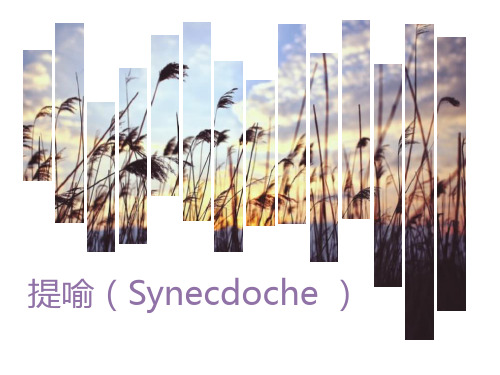
定义
提喻(synecdoche),意为“解释”,又称“举隅”,指的 是在同一性质、同一种类、同一体的事物中,用包罗性广 的(more comprehensive)词语代替包罗性更窄的 (less comprehensive) 词语,或反过来用后者代替前者。 提喻是不直接说某一事物的名称,而是借事物的本身所呈 现的各种对应的现象来表现该事物的这样一种修辞手段。 提喻又称举偶法。提喻与换喻(借代)不同,换喻主要借 助于密切的关系与联想,而提喻则是借助于部分相似。 提喻的本体和借体之间纯属隶属关系,而非对应关系。本 体是借体的体现,而借体则蕴含于借体。
以“士兵”代替“将军或指挥官”
2. The dock can accommodate the largest vessel. 这船坞能容纳最大的船。 以“容器”代替“船只”
七、以物质名词代替所制成的东西
1.She has been on the boards for more tha twenty years. 她在舞台上度过了20多个春秋。
三、以具体代替抽象
1.She has come to realize that life is not a bed of roses. 她终于意识到了人生并非总是称心如意。 以具体的“洒满玫瑰的床”(a bed of roses)来代替“豪华舒适和欢乐安 逸的生活" 2.All the father rises in my breast.
舐犊之情在我心中油然而生。
以“父亲”(father)代替“父亲的情感和责任”。 3.The wolf and the pig mingled together in his face. 残暴和贪婪交织在他的脸上。 分别以“狼”代替“残暴",以“猪”代替“贪婪"
转喻法提喻法等的区别

转喻法(metony my)提喻法(synecd oche)和换称(antono masia)讲解及举例对比分析转喻(metony my)提喻(synecd oche)换称(antono masia)这三种修辞手法都属于关系类修辞,他们的共同之处都是用某一事物的名称指代另一事物的名称。
目前国内有关英语修辞的教科书中就常将这三种修辞手法混为一谈,使老师和学生对此模糊不清。
其实,如果将这三种修辞手法的定义和用法弄清,就不难区分了。
下面就这三种修辞手法的定义、用法以及它们之间的异同做些比较。
1.转喻的定义与用法用某一事物的名称代替另一事物的名称的修辞手法叫做转喻或借代。
这两种事物之间有着密切相关的联系。
转喻通常用下列几种方式指代。
(1)根据人名或商品品牌名:UncleSam(山姆大叔)——Americ ans or the Americ an govern ment(美国人/美国政府)John Bull(约翰牛)——the Englis h nation or a typica l Englis hman(英国/地道英国人)He is readin g Shakes peare. 他在读莎士比亚作品(Shakes peare’sworks用作者指代作品)He went in debt just to keep up with the Jonese s.他为了玉邻里攀比而负债。
(Jonese s :neighb ors 用“琼斯家”指代“邻里”)We drovea Ford to Hyde Park. 我们驾驶一辆福特牌小轿车到海德公园去。
(Ford :a car whosemake is Ford 用品牌名指代实物)(2)根据实物名称Finall y she marrie d money.她最终嫁给了有钱人。
转喻、提喻、换称三种修辞手法的对比

THE COMPARISON BETWEEN METONYMY,SYNECDOCHE AND ANTONOMASIA转喻、提喻、换称三种修辞手法的对比转喻(Metonymy)、提喻(synecdoche)、换称(antonomasia)这三种修辞手法都属于关系类修辞,它们的共同之处都是用某一事物的名称指代另一事物的名称,故而常常容易使人混淆。
目前国内有关英语修辞的教科书中就常将这三种修辞手法混为一谈,使得老师和学生对此模糊不清。
其实,如果将这三种修辞手法的定义和用法弄清,就不难区分它们。
下面就这三种修辞手法的定义、用法以及它们之间的异同等作些比较:一.转喻(Metonymy)的定义与用法:1.定义:用某一事物的名称代替另一事物的名称的修辞手法叫做转喻或借代。
这两种事物之间有着密切相关的联系。
(A metonymy is a figure of speech that has to do with the substitution of the name of one thing for that of another with which it is closely associated.)2.用法:转喻通常用下列几种方式指代:①根据人名或商品品牌名:Uncle Sam(山姆大叔)→Americans or the American government(美国人/美国政府)John Bull(约翰牛)→the English nation or a typical Englishman(英国/地道英国人)He is reading Shakespeare. 他在读莎士比亚作品。
Shakespeare's works (用作者指代作品)He went in debt just to keep up with the Joneses. 他为了与邻里攀比而负债。
neighbours(用“琼斯家”指代“邻里”)We drove a Ford to Hyde Park. 我们驾驶一辆福特牌小轿车到海德公园去。
提喻和转喻的区别例子
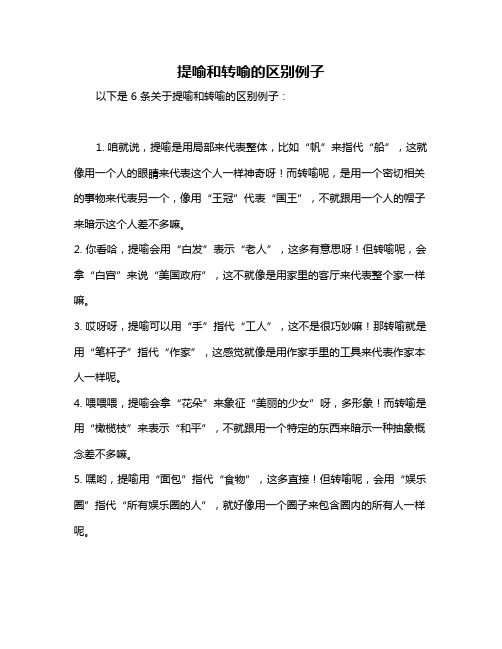
提喻和转喻的区别例子
以下是 6 条关于提喻和转喻的区别例子:
1. 咱就说,提喻是用局部来代表整体,比如“帆”来指代“船”,这就像用一个人的眼睛来代表这个人一样神奇呀!而转喻呢,是用一个密切相关的事物来代表另一个,像用“王冠”代表“国王”,不就跟用一个人的帽子来暗示这个人差不多嘛。
2. 你看哈,提喻会用“白发”表示“老人”,这多有意思呀!但转喻呢,会拿“白宫”来说“美国政府”,这不就像是用家里的客厅来代表整个家一样嘛。
3. 哎呀呀,提喻可以用“手”指代“工人”,这不是很巧妙嘛!那转喻就是用“笔杆子”指代“作家”,这感觉就像是用作家手里的工具来代表作家本人一样呢。
4. 喂喂喂,提喻会拿“花朵”来象征“美丽的少女”呀,多形象!而转喻是用“橄榄枝”来表示“和平”,不就跟用一个特定的东西来暗示一种抽象概念差不多嘛。
5. 嘿哟,提喻用“面包”指代“食物”,这多直接!但转喻呢,会用“娱乐圈”指代“所有娱乐圈的人”,就好像用一个圈子来包含圈内的所有人一样呢。
6. 哇塞,提喻可以用“车轮”表示“车”,好神奇诶!转喻则是用“华尔街”来指代“美国金融界”,这不就像是用一条街来概括一个行业嘛。
总之呢,提喻和转喻区别还是很大的呀,一个是局部与整体或象征关系,一个是密切相关事物的指代,得好好区分才行呢!。
转喻法提喻法和换称等地例句和区别
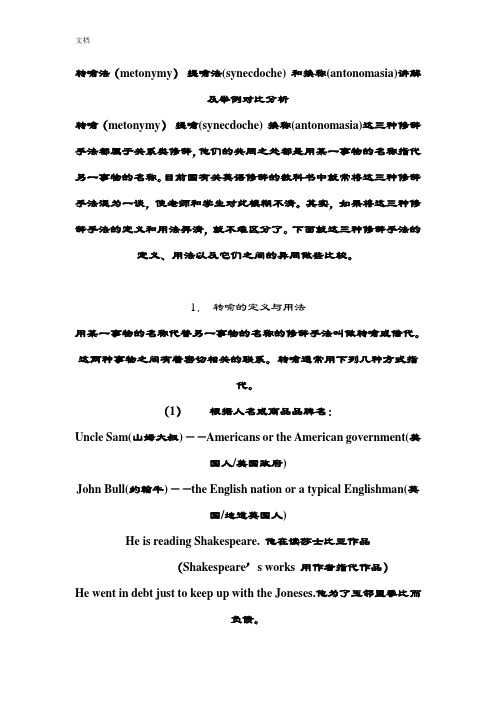
转喻法(metonymy)提喻法(synecdoche) 和换称(antonomasia)讲解及举例对比分析转喻(metonymy)提喻(synecdoche) 换称(antonomasia)这三种修辞手法都属于关系类修辞,他们的共同之处都是用某一事物的名称指代另一事物的名称。
目前国有关英语修辞的教科书中就常将这三种修辞手法混为一谈,使老师和学生对此模糊不清。
其实,如果将这三种修辞手法的定义和用法弄清,就不难区分了。
下面就这三种修辞手法的定义、用法以及它们之间的异同做些比较。
1.转喻的定义与用法用某一事物的名称代替另一事物的名称的修辞手法叫做转喻或借代。
这两种事物之间有着密切相关的联系。
转喻通常用下列几种方式指代。
(1)根据人名或商品品牌名:Uncle Sam(山姆大叔)——Americans or the American government(美国人/美国政府)John Bull(约翰牛)——the English nation or a typical Englishman(英国/地道英国人)He is reading Shakespeare. 他在读莎士比亚作品(Shakespeare’s works 用作者指代作品)He went in debt just to keep up with the Joneses.他为了玉邻里攀比而负债。
(Joneses :neighbors 用“琼斯家”指代“邻里”)We drove a Ford to Hyde Park. 我们驾驶一辆福特牌小轿车到海德公园去。
(Ford :a car whose make is Ford 用品牌名指代实物)(2)根据实物名称Finally she married money. 她最终嫁给了有钱人。
(a rich man用“钱”指代“有钱人”)I live near an airport and passing planes can be heard night and day.我住在飞机场附近,日夜可听到过往的飞机声。
换喻与提喻的修辞差异及其认知价值在英语篇章学习中的应用

换喻与提喻的修辞差异及其认知价值在英语篇章学习中的应用作者:于爱莲来源:《职业时空》2008年第07期Metonymy这种修辞格是指用一个事物的名称代替与它相关的另一个事物的名称。
它是英语中常见的修辞手段,实质上讲是概念接近事物之间的一种比拟与替代。
其特点在于不直接说出要表达的人和事物的名称,而是通过联想用人们所熟知的与本体事物有密切关系的事物名称来代替,利用两个对象之间的某种联系来唤起别人的联想,可以做到形象鲜明但不生硬直接。
目前我国认知语言学界许多学者都将其译为“转喻、换喻”。
而synecdoche这种修辞格是指以部分代替整体或以整体代替部分;以某种事物代替某类事物或以某类事物代替某种事物;以原材料的名称代替其制成品。
也是英语最重要的修辞手法之一。
Synecdoche具有言近意远、因微见著、举一反三的认识论价值,同时还蕴含着一层感情宣泄的功能,使人的认识从表面的视觉提高到深刻的洞察。
目前对synecdoche普遍接受的汉语译名为提喻。
本文分析了换喻和提喻所表现出的不同的认知过程及在英语篇章学习中的认知价值。
一、换喻与提喻的用法差异性探究换喻和提喻是英语常用的修辞手法。
这两种修辞手法因其相似的概念而往往被混淆。
然而它们是两种不同的修辞格。
(一)换喻——紧密相关事物之间的比拟换喻常用的表达方式主要有:借容器代内容;借特征或特定环境代该特征或环境下的人;借工具代工具所起的作用或工具的所有者;借作者名代作品名称;借历史典故代现实。
1.借容器代容器里的内容。
例如:a.The kettle is boiling.(水开了。
),b.We discussed the matter over a bottle.(我们边饮酒边讨论此事。
)a句中用壶这一盛水的容器来代替与之紧密相关的装在里面的水;b句中用bottle(瓶)这一容器代替瓶中的酒。
2.借特征或特定环境代该特征或环境下的人。
例如:a.The gray hair should be more experienced.(老年人会更有经验。
换喻与提喻差异的认知分析

第 2卷 第 2期 21 0 0年 4月
当代 教 育 理 论 与 实 践
Th o ̄ a d Prcie o ne p r r d c t n e n a t fCo t m o a y E u a i c o
提 喻作 为一种重要 的修辞手 法 , 是借 用和该人 或该 物 密切相关 的词来 代替该人 或该事 物 , 重点 突 出局 部代替 整 体或整体代替局部 。例如 : oehn sa edda hr s M r ad r nee t av t e e te i .这里是用部分代整体 ,ad是人 身体 的一部分 , m h n 由于 收获时节人们 劳作 时 , 的作 用 最 明显 , 以借用 手 来指 手 所
响。认 知语 言学 认 为 , 喻 和 提 喻不 仅 是 语 言 或修 辞 问 换 题, 更是人类概 念系统 的一 部分 。L kf 于 18 ao 97年提 出了
织、 四肢或器官 借代抽 象 的行 为或 能力 ; 以人名 借 代事 物
或观念 ; 动、 物 借代 某 种 特 征 ; 理 上 的局 部 借 代 整 以 植 地
们为了避免混乱 , 少专门术 语都把 s edc e限定在 ‘ 不 n y c oh 部 分与整体 ’ 围之 内。汉语 修 辞也 有类 似倾 向 , 的修 辞 范 有
对于换喻和提喻 的 区分 , 国南教 授认 为 : m tnmy 李 “ eoy 中两个 名称的所指应 属迥然 不 同的两个 事物 , 只是 由于两 者 总是处于 ‘ 同现关 系 ’ 中才 取而 代 之 。而 sn coh yed ce中
转喻、提喻、换称的区别

转喻、提喻、换称的区别转喻(metonymy)提喻(synecdoche) 换称(antonomasia)这三种修辞手法都属于关系类修辞,他们的共同之处都是用某一事物的名称指代另一事物的名称。
目前国内有关英语修辞的教科书中就常将这三种修辞手法混为一谈,使老师和学生对此模糊不清。
其实,如果将这三种修辞手法的定义和用法弄清,就不难区分了。
下面就这三种修辞手法的定义、用法以及它们之间的异同做些比较。
1.转喻的定义与用法用某一事物的名称代替另一事物的名称的修辞手法叫做转喻或借代。
这两种事物之间有着密切相关的联系。
转喻通常用下列几种方式指代。
(1)根据人名或商品品牌名:Uncle Sam(山姆大叔)——Americans or the American government(美国人/美国政府)John Bull(约翰牛)——the English nation or a typical Englishman(英国/地道英国人)He is reading Shakespeare. 他在读莎士比亚作品(Shakespeare’s works 用作者指代作品)He went in debt just to keep up with the Joneses.他为了玉邻里攀比而负债。
(Joneses :neighbors 用“琼斯家”指代“邻里”)We drove a Ford to Hyde Park. 我们驾驶一辆福特牌小轿车到海德公园去。
(Ford :a car whose make is Ford 用品牌名指代实物)(2)根据实物名称Finally she married money. 她最终嫁给了有钱人。
(a rich man用“钱”指代“有钱人”)I live near an airport and passing planes can be heard nightand day.我住在飞机场附近,日夜可听到过往的飞机声。
古诗词中的提喻法,因果型意象

古诗词中的提喻法,因果型意象
“提喻法”是类比族技法的典型代表。
其特点是以大量的联想为基础,以不同事物之间的相同或类似点为纽带,充分调动想象、直觉、灵感诸功能,巧妙的借助其他事物找出创意的突破口。
提喻(Synecdoche),并不是中文词汇。
但相当于就是借代,指代。
提喻是不直接说某一事物的名称,而是借事物的本身所呈现的各种对应的现象来表现该事物的这样一种修辞手段。
提喻又称举偶法。
提喻与换喻(借代)不同,换喻主要借助于密切的关系与联想,而提喻则是借助于部分相似。
因果性意象,杨柳表现离情别恨或柔情杨花象征离散
梧桐表现寂寞惆怅、凄苦凄凉悲伤木叶表现惆怅落寞的心境梅花象征高洁或不屈不挠纯净洁白兰花象征高洁、美好
菊花象征隐逸、高洁、脱俗、高雅竹象征正直、不从俗、向上、有气节
桃花形容美女的容颜牡丹表现富贵、美好松柏高洁、坚强、坚贞或富有生命力绿叶表现希望、活力。
比喻的几种变式

比喻的几种变式
比喻的变式形态主要分为引喻、提喻、较喻、反喻、交喻、回喻、博喻、连喻、类喻、进喻、互喻、缩喻、约喻、兼喻、合喻等多种形态。
1.引喻,又称“对喻”“类比”等,本体和喻体同时出现,但是没有喻词。
按照形式标准分类,属于隐喻的一种形式。
例如“每天都有一群起早贪黑的‘小蜜蜂’,快看啊!就是那群环卫工人。
”就是引喻的典型例子。
2.反喻,又称“非喻”,是从否定的角度进行设喻,喻词大多是“非”“不像”“不是”等词语。
按照形式标准分类,属于“明喻”的一种形式。
例如,“人非草木,孰能无情?”就是反喻的典型例子。
3.约喻,比喻的一种,几个本体公用一个喻体。
按照形式标准分类,约喻由于大多数包含喻词“像”,所以属于明喻的一种类型。
例如,“苹果、香蕉、荔枝。
这些图片像我的梦中情人一样无一不在诱惑着我。
”就是约喻的典型例子。
4.博喻,又称“多项喻”,就是用几个喻体从不同角度反复设喻去说明一个本体。
按照形式标准分类,博喻由于多使用喻词“像”“如”等,所以属于明喻的一种形式。
例如,“这冬天的雪像烟一样轻,像银一样白”就是博喻的典型例子。
- 1、下载文档前请自行甄别文档内容的完整性,平台不提供额外的编辑、内容补充、找答案等附加服务。
- 2、"仅部分预览"的文档,不可在线预览部分如存在完整性等问题,可反馈申请退款(可完整预览的文档不适用该条件!)。
- 3、如文档侵犯您的权益,请联系客服反馈,我们会尽快为您处理(人工客服工作时间:9:00-18:30)。
The American Heritage® Dictionary of the English Language: Fourth Edition. 2000. synecdoche
SYLLABICATION: syn·ec·do·che
NOUN: A figure of speech in which a part is used for the whole (as hand for sailor), the whole for a part (as the law for police officer), the specific for the general (as cutthroat for assassin), the general for the specific (as thief for pickpocket), or the material for the thing made from it (as steel for sword).
ETYMOLOGY: Middle English synodoches, from Medieval Latin synodoche, alteration of Latin synecdoch, from Greek sunekdokh, from sunekdekhesthai, to take on a share of : sun-, syn- + ekdekhesthai, to understand ( ek-, out of; see eghs in Appendix I + dekhesthai, to take; see dek- in Appendix I).
_______
The American Heritage® Dictionary of the English Language: Fourth Edition. 2000. metonymy
SYLLABICATION: me·ton·y·my
PRONUNCIATION: m-tn-m
NOUN: Inflected forms: pl. me·ton·y·mies
A figure of speech in which one word or phrase is substituted for another with which it is closely associated, as in the use of Washington for the United States government or of the sword for military power.
ETYMOLOGY: Late Latin metnymia, from Greek metnumi : meta-, meta- + onuma, name; see n-men- in Appendix I.
OTHER FORMS: meto·nymic (mt-nmk) , meto·nymi·cal —ADJECTIVE meto·nymi·cal·ly —ADVERB
____________________
The American Heritage® Dictionary of the English Language: Fourth Edition. 2000. metaphor
SYLLABICATION: met·a·phor
PRONUNCIATION: mt-fôr, -fr
NOUN: 1. A figure of speech in which a word or phrase that ordinarily designates one thing is used to designate another, thus making an implicit comparison, as in “a sea of troubles” or “All the world's a stage” (Shakespeare). 2. One thing conceived as representing another; a symbol: “Hollywood has always been an irresistible, prefabricated metaphor for the crass, the materialistic,
the shallow, and the craven” (Neal Gabler, New York Times Book Review November 23, 1986). ETYMOLOGY: Middle English methaphor, from Old French metaphore, from Latin metaphora, from Greek, transference, metaphor, from metapherein, to transfer : meta-, meta- + pherein, to carry; see bher-1 in Appendix I.
OTHER FORMS: meta·phoric (-fôrk, -fr-) , meta·phori·cal —ADJECTIVE meta·phori·cal·ly —ADVERB
Synecdoche应该译作提喻或举隅
Metonymy译做转喻换喻
Metaphor译做暗喻隐喻
汉语的借代包含英语的提喻和换喻。
提喻是用事物的一部分代替整体。
换喻是用与某事物有关的另一种事物代替这个事物。
汉语修辞对这两者不加区分,统称为借代。
换喻(metonymy)
换喻反映两个密切相关的事物的现实关系,换喻与比喻(明喻或暗喻)不同,不需要两个事物对比,而是借用伴随或附属与某一事物的另一事物的名称来代替某事物的名称。
所谓换喻,说的是一个事物,不过是换一种说法来表现而已。
英语词义的扩大除通过暗喻外,还通过换喻的方式实现,如board不只是桌子,后来也指坐在会议桌边的人。
换喻可以使表达多样化、简洁、动人。
英诗中常用换喻来避免一般化,使形象具体生动,如用grave表达“死亡”。
新闻文字,报刊大标题中也常出现换喻,如用Pentagon(五角大楼)代替美国国防部。
英语中常见的换喻有以下几种:
1. 用一个事物来象征人或另一事物:
From the cradle to grave(从生到死)
2. 用工具或器官来代替本体:
The pen has more influence than the sword.
He has an eye for beauty.
3. 用容器的名称来代替所盛的东西:
They serve Chinese dishes. (中餐)
The whole village came out to welcome the singers. (全村的人)
4. 用制造者的名字代表制成品:
I have never read homer
5. 用地方代替事物:
White House (美国总统)
Kremlin (苏联政府)
汉语中通常把这一修辞格称作旁借,也就是借事物本身所呈现的某一现象(特征或标志等)
或某些关系(所在、所属、产地、材料或工具)来表现,如用“三角眼”代替“长着一对三角眼的人”,用“红领巾”代替“少先队员”,用神舟指中国,用“龙井”等地名代替那里产的茶叶等等。
提喻(synecdoche)
提喻也是不直说某一事物的名称,而是借事物本身所呈现的各种对应的现象来表现。
提喻与换喻不同,换喻主要借助于密切的关系与联想,而提喻则是借助于部分相似。
提喻通常是用局部来代替整体,间或也有整体来代替局部,局部与整体之间总有相似之处。
常见的提喻:
1.用局部代替整体:
Many hands make light work. (用hand表示干活的人)
The case was defended by eloquent lips. (用lip表示有辩才的人)
2.用整体代替局部:
It was a close contest. In the end, China won. (用China代表中国队)
3.用个体代替整个一类:
She is another Madam Curie.
4.用具体代替抽象
5.用抽象代替具体
The authorities (当局)
6.用材料代替事物
A piggy-bank full of coppers
汉语的这种修辞方式叫做对代,如用部分代整体:不拿群众一针一线;用特称代通称:千万个雷锋在成长;用具体代抽象:他自有他的小算盘(几个人打算)。
《英语文体学引论》王佐良、丁往道2004.6 外语教育与研究出版社。
